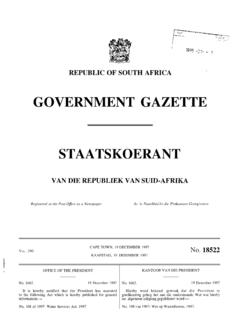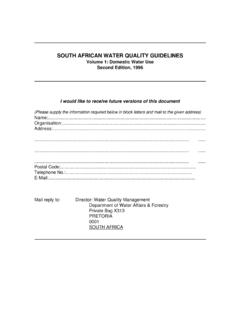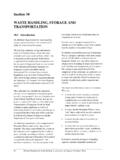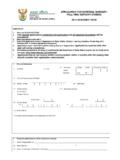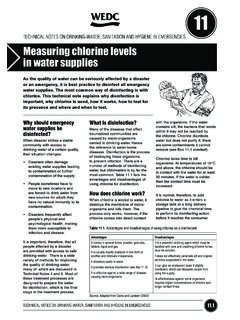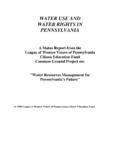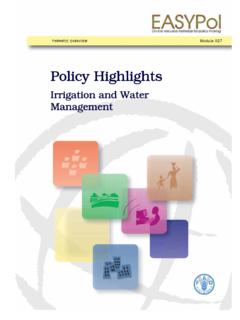Transcription of Water for Growth and Development in South Africa - DWAF
1 Water for Growth and Development in South Africa Version 6. 1 Executive Summary The Department of Water Affairs and Forestry (DWAF) has embarked upon a process to develop a framework that will set in motion a course of action to ensure that there is sufficient Water , in both quantitative and qualitative terms, to support South Africa 's path of Growth and Development . There must be sufficient Water for the country to achieve its 6% economic Growth target. At the same time, every person in South Africa must have access to potable Water . These two goals must be achieved by not compromising the ecological sustainability of the resource. The Department has also embarked upon rigorous Water assessment studies referred to as Reconciliation Strategies in order to achieve the reconciliation of supply and demand for both Water scarce areas as well as those experiencing relatively high levels of demand.
2 These strategies aim to ensure the supply of Water at adequate levels of assurance within the constraints of affordability and appropriate levels of service to users and protection of current and possible future Water resources. Thus far, six strategies have been undertaken in the major urban centres and in July 2008, the Department commissioned reconciliation strategies for every town in the country, due to be completed by 2011. Water scarcity has been identified in the major urban centres. These major urban areas anchor the country's economy, and the Department has reached a point where it knows that it must invest heavily in the diversification of its Water mix to avert serious Water shortages that could impact adversely on our economy.
3 In addition to the traditional augmentation schemes, there are two major ways that Water supplies can be augmented. These are the treatment of effluent and the desalination of sea Water for productive use, thereby rendering primary Water sources for the domestic use. A key principle behind assuring local Water supplies is that the Water supply should be as close to the end-user as possible, avoiding the unnecessary intensification of costs associated with the transportation of Water . The Department also appreciates that whilst it invests in schemes to assure Water supply, it is also required to strengthen its focus on Water conservation and Water demand management, especially since a very basic cost analysis shows that there is a greater return on investment through Water loss control and Water use efficiency measures than supply- side interventions.
4 A major source of Water loss is ageing infrastructure exacerbated by poor operations and maintenance at a municipal level and analysis shows that this state of affairs is a multi-faceted problem including a lack of managerial and technical skills and funding. The Department will strengthen its efforts to support this sector in a bid to reverse this dire situation; it becomes an even more crucial intervention when one factors in the pollution of Water sources due to faulty wastewater treatment works. The notion of Water for Development alludes to the role of Water in the alleviation of poverty and people's constitutional rights to have access to a source of safe and reliable drinking Water . The Department is deeply concerned about the persistent backlogs in particular parts of the country although it has achieved the Millennium Development Goal of halving, by the year the proportion of people who are unable to reach or to afford safe drinking Water in 2005.
5 The Department is also very aware of the anomalies in Water distribution, where people reside adjacent to Water sources and yet have no access to these. The Department will achieve the target of ensuring that every person has access to safe and reliable supply of drinking Water although it has to reconsider how this can be achieved. It is the Department's recommendation that the service backlogs, which are predominantly situated in KwaZulu-Natal, Eastern Cape, Limpopo, and the North West province, are prioritised and addressed through a combination of short-term interventions such as rainwater harvesting, exploring further options of supply communities from available sources and the further Water for Growth and Development Framework i exploitation of groundwater sources, which may necessitate a policy change.
6 Ultimately, a balance needs to be struck between large and small-scale infrastructure projects. Where a community can be serviced by existing large-scale infrastructure, this should happen with immediate effect. Where a community cannot be serviced by a large-scale infrastructure project due to the cost of such an intervention (for example, pumping Water to mountain- top communities at higher altitudes), then small-scale schemes must be planned and implemented. Where large-scale infrastructure could solve local Water scarcity, such as the De Hoop Dam, the necessary planning and resourcing must be undertaken and interim measures introduced to compensate for the long lead-times. The Department should also prioritise schemes in areas with resource Development potential that coincide with areas with high service backlogs.
7 It will also support sector plans where Water use for Growth purposes can simultaneously support Water use for Development purposes. The Department will seek out and support interventions that support the dual goals of Water for Growth and Development as one goal should not be at the expense of the other. Water for Growth points to the relationship between Water availability and the forms of economic activity that are dependent on available Water supply of varying levels of quality depending on the technologies being used. The Department's position is that it would like to support the country's economic Growth target of 6% but this cannot be at the expense of the ecological sustainability of the resource or people's primary needs.
8 It wishes to be responsive to the needs of the different economic sectors and this can only be achieved if these sectors factor in Water implications (supply and impact of use) at the outset. Rather than being an add-on or afterthought, the Department sees the need for Water to be mainstreamed and placed at the nucleus of all planning decisions, whether these be within the public or private sector. Water can only support economic Growth , without compromising primary needs or ecological sustainability if, and only if, its availability is adequately factored in. Apart from ensuring Water availability for Growth purposes, the Department is very mindful of Water use behaviour that impacts negatively on both Water resource quantity and quality.
9 It is currently exploring a potential mix of mechanisms to change this behaviour, which include regulatory instruments, market-based instruments, self-regulation, and awareness and education, and it will match appropriate mechanisms to mitigate offending behaviour. The Department is satisfied that it is taking the required course of action to ensure that it has the right kind of information at its disposal to make better informed and calculated decisions and trade-offs with respect to Water in support of cross-sectoral planning and Development initiatives. The rolling out of the Reconciliation Strategies to all parts of the country will ensure that the Department is able to anticipate and address future demand without any one area of Water need social, economic and ecological being compromised.
10 High level recommendations Strengthening institutional capacity While the Reconciliation Strategies identify potential Water imbalances and interventions to be taken to avert Water shortages, if the Department does not have the capacity to oversee the implementation of these strategies as well as other aspects of its mandate, Water shortages may be a consequence of Departmental inefficiencies and poor management rather than a deficiency of supply. The Department has embarked on a process of institutional re-alignment to ensure that the Catchment Management Agencies, and in their absence, the Regions, are able to fulfil the role of implementing agents tasked with an array of Water resource management functions. Water for Growth and Development Framework ii Mainstreaming Water It is the Department's intention to ensure that Water is placed at the heart of all planning decisions taking place in the country; to ensure that any decisions taken that rely on the steady supply of Water , both in quantitative and qualitative terms, adequately factor in Water availability.
